T'yr Dellos
Imperial
ISH Assault Chassis Internal Complex
Intent: To boldly go where no sub has gone before
LOCATION INFORMATION
Name: ISH Assault Chassis Internal Complex
Classification: Internal Complex
Location: On a Boat
Affiliation: Owner of Boat
Population: (Typically) 1,785 - 6,200 Crewmen and Officers and up to 2,040 Stormtroopers
Defenses: Droids, Stormtroopers, Crew, Life Support
DESCRIPTION
POINTS OF INTEREST
Bridge-
Images




The Bridge of the Victory III-class Star Destroyer adopts a fairly classical design structure.
Command Walkway:
Main Viewports / Control Stations:
Crew Pit:
Control Consoles:
Port/Starboard Stations -
Point Defense Control Station:
Weapons Control Station:
Shuttle Operations Station:
Starfighter Operations Station:
Sensor Tech Station:
Communications Tech Stations:
Internal Security Control Room:
Ship Information Center:
Officer's Meeting Room:
Primary Army Operations Control Room:
Secondary Army Operations Control Room:
Hanger-
Images


vehicles stored above main hanger. Vehicle maintenance area below main hanger.
Containment Shield, Ray Shield, Blast Doors
Main entry area, open, capable of holding a ship upto 150m in size...
Docking Ports and Cargo Bays-
Images

- Primary cargo bay (1 or 4)

- Hallways leading from cargo bays
Along the port and starboard axial edge of the Star Destroyer, a pair of docking bays is located just aft of the hanger and just fore of the atmospheric maneuvering surfaces. These docking bays are oversized versions of standard docking tubes and are intended for use connecting with other star destroyers and large space stations. These bays connect directly to the hanger, cargo bays, and engineering sections via a number of large hallways specially designed for the movement of large crates and other cargo. A number of smaller docking ports are available for use on the dorsal superstructure of the Victory III, located just below the main tower on the port and starboard side of the ship. For ships with incompatible docking tubes, deployable cofferdams can be utilized to connect a smaller ship with the Victory III while the Star Destroyer's tractor beam projectors hold the opposing ship still.
Four separate cargo bays are spread throughout the Victory III's design. Each of these cargo bays is connected to each other and to the docking bays via a system of large, reinforced hallways specially designed for the transport of large, heavy containers of potentially volatile substances. Built into the ceiling of each hallway is a rail system that allows a number of small tractor beam emitters to slide along the hallway moving cargo from one area to another. Each emitter is capable of lifting upto 900kg at a range of upto 30 meters. Built into the floor of each hallway is an identical rail system that allows a number of small pressor field emitters to slide along the hallway moving cargo from one area to another. The design of the ceiling and floor rail system does not allow for two emitters to pass one another on the same railing. For that reason, tractor beam emitters are typically used to move cargo down a given hallway in one direction, and pressor field emitters are used to move cargo in the other direction. In instances where cargo is being moved that is too large to allow for other cargo to pass between it and the ceiling or wall of the hallway, a red light is illuminated at all other entry points to the hallway notifying crew that they must wait before they move cargo through that hallway.
Each cargo bay within the Victory III Star Destroyer is capable of holding roughly 2,025 tons of cargo. This cargo is typically food, water, ordnance, and other mission-specific supplies. All cargo containers used on Victory III Star Destroyers are built with a magnetic frame to secure during flight. Those crates, drums, or other forms of cargo that do not come with such magnetic securing capabilities are not authorized aboard the ship until a spare frame can be found and secured to the cargo in question. Typically though, all cargo containers scheduled for use on a Victory III Star Destroyer are specifically chosen due to their compliance with the demands of the ship in mind.
Crew Quarters-
Images
The sleeping areas of the Victory III's crew quarters are broken up into small, standard rooms with two bunkbed-like sleeping racks worked into one of the walls and a small desk with a pair of chairs. The room contains four personal lockers with enough room for three sets of boots, five pair of military and civilian outfits, and a number of other personal effects. A small privacy curtain is often added to the room for discretion while changing. A number of these rooms are worked into either side of a hallway to the port and starboard of a main corridor running through the crew quarters section of the ship. At the end of each hallway is a communal bathing and toiletry room. Each of these hallways are segregated by sex and species. Should the needs of the crew require it, the entire length of hallway, bathing room, and individual sleeping quarters of a hallway can be isolated and provided with a specific non-standard atmosphere. Row after row of these hallways line a sizable stretch of the Victory III's interior as the majority of the ship's 6,000 crew are squeezed into only a few hundred square meters of personal quarters. To further facilitate the smooth consolidation of living arrangements, duty rosters are often drafted in a manner that ensures that half of every room's occupants are always on duty while the other half are on their assigned break periods. To help with this, protocol droids are often acquired and tasked with the delicate job of keeping track of social conflict within the crew and adjusting the duty roster and living arrangements to minimize this.
Sleeping arrangements, training areas, drill procedures?
Barber Shop next to gym/training area
Officer's Quarters-
Intent: To boldly go where no sub has gone before
LOCATION INFORMATION
Name: ISH Assault Chassis Internal Complex
Classification: Internal Complex
Location: On a Boat
Affiliation: Owner of Boat
Population: (Typically) 1,785 - 6,200 Crewmen and Officers and up to 2,040 Stormtroopers
Defenses: Droids, Stormtroopers, Crew, Life Support
DESCRIPTION
POINTS OF INTEREST
Bridge-
Images
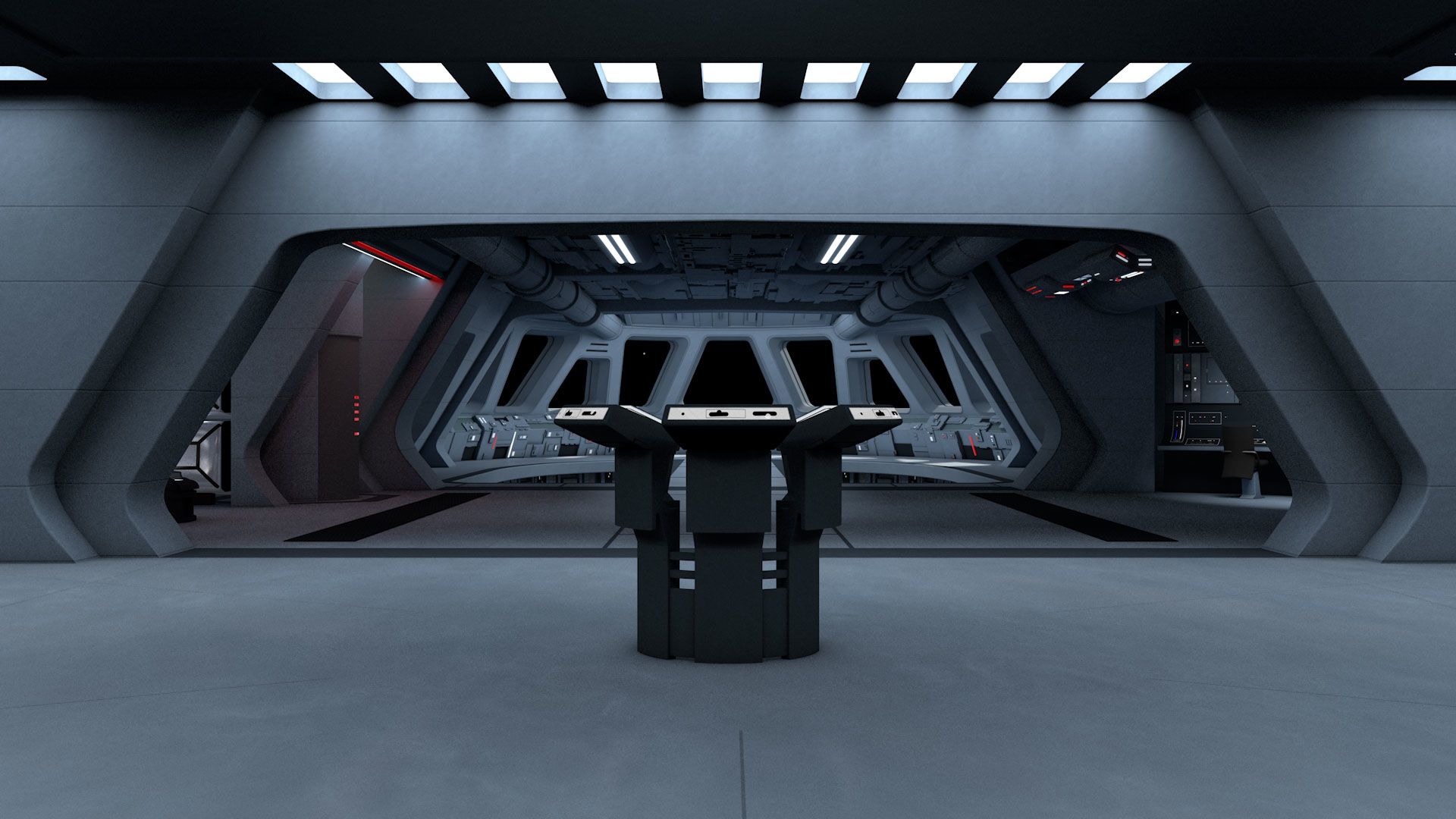


The Bridge of the Victory III-class Star Destroyer adopts a fairly classical design structure.
Command Walkway:
Main Viewports / Control Stations:
Crew Pit:
Control Consoles:
Port/Starboard Stations -
Point Defense Control Station:
Weapons Control Station:
Shuttle Operations Station:
Starfighter Operations Station:
Sensor Tech Station:
Communications Tech Stations:
Internal Security Control Room:
Ship Information Center:
Officer's Meeting Room:
Primary Army Operations Control Room:
Secondary Army Operations Control Room:
Hanger-
Images

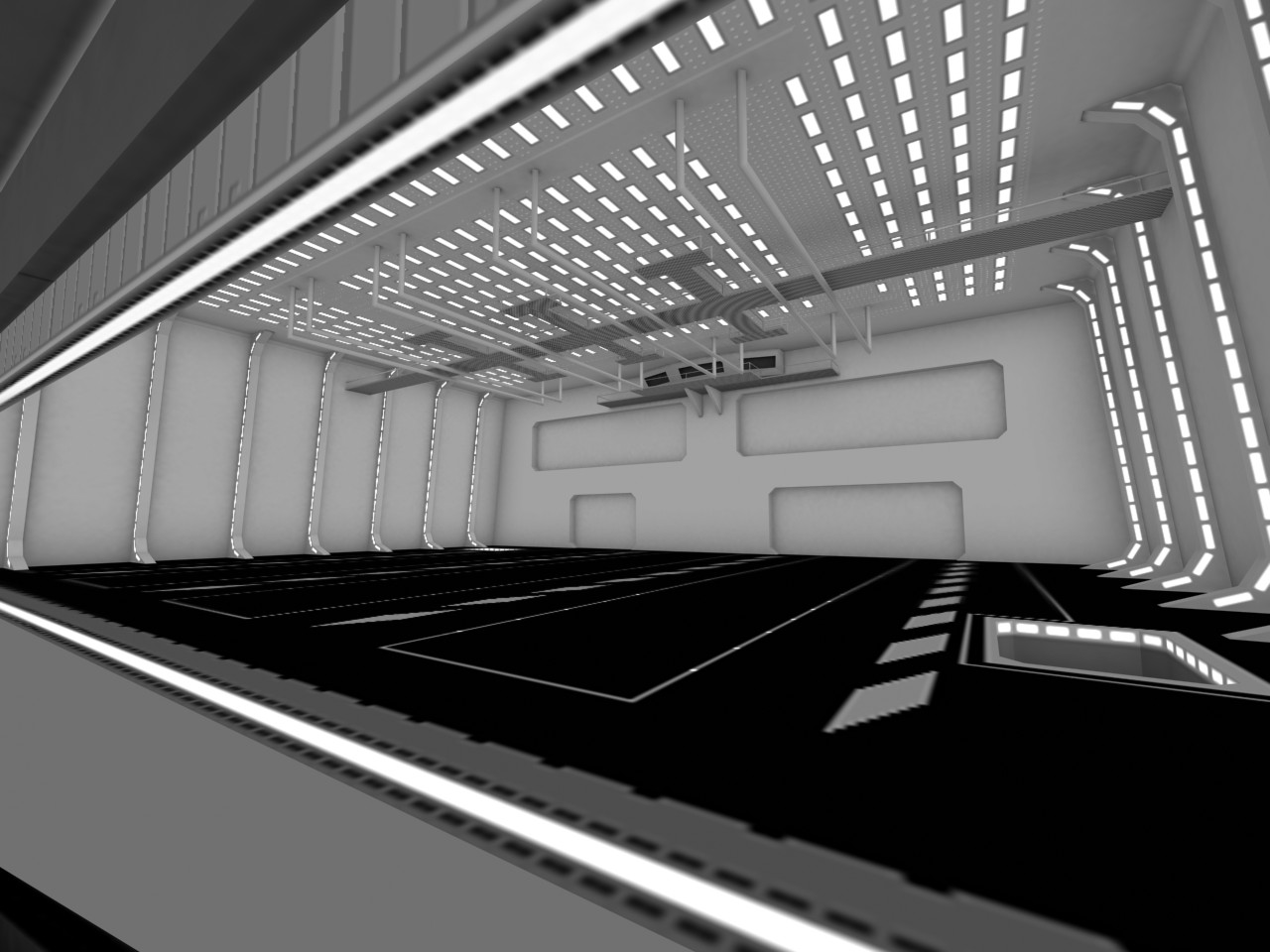
vehicles stored above main hanger. Vehicle maintenance area below main hanger.
Containment Shield, Ray Shield, Blast Doors
Main entry area, open, capable of holding a ship upto 150m in size...
Docking Ports and Cargo Bays-
Images
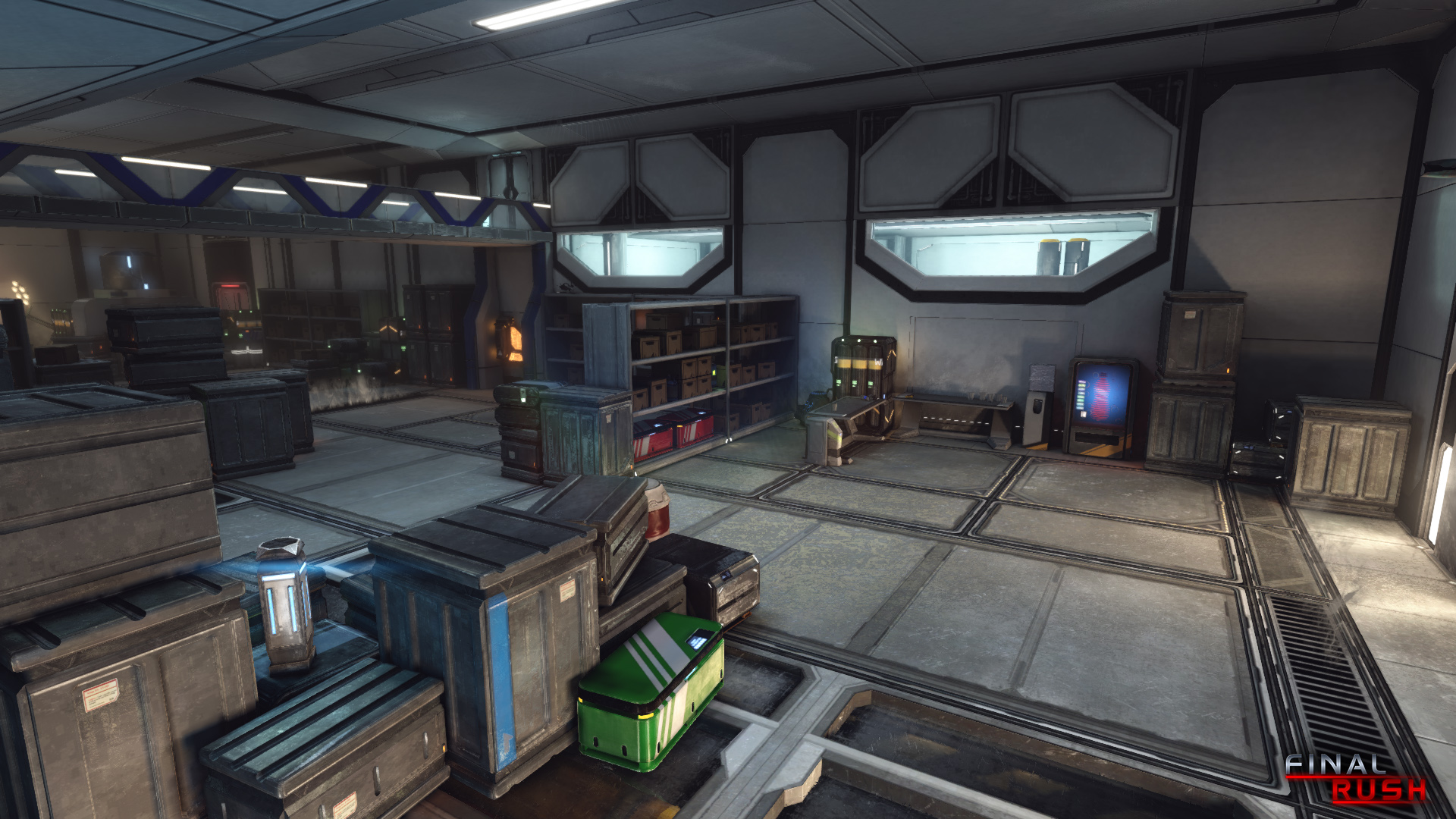
- Primary cargo bay (1 or 4)
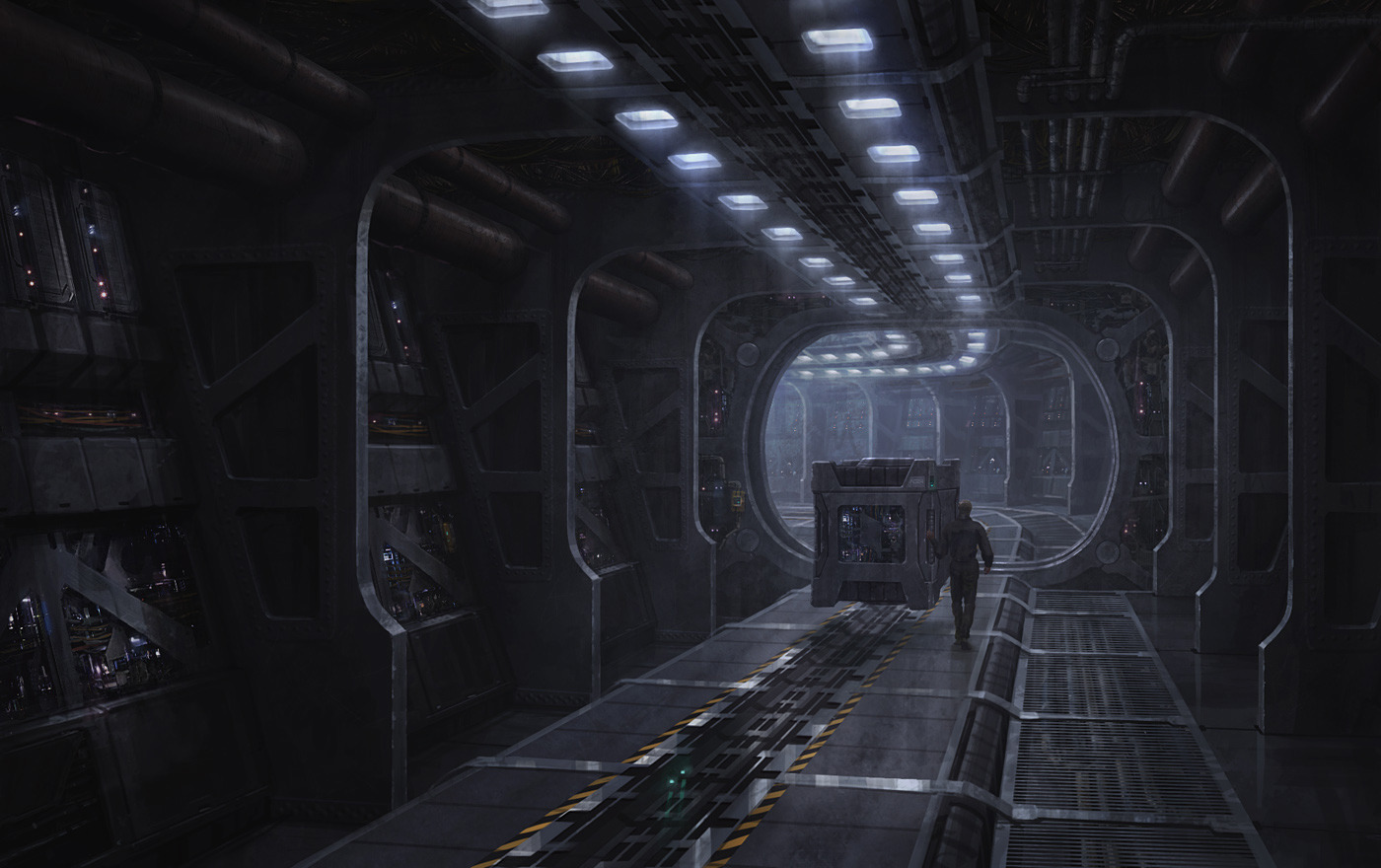
- Hallways leading from cargo bays
Along the port and starboard axial edge of the Star Destroyer, a pair of docking bays is located just aft of the hanger and just fore of the atmospheric maneuvering surfaces. These docking bays are oversized versions of standard docking tubes and are intended for use connecting with other star destroyers and large space stations. These bays connect directly to the hanger, cargo bays, and engineering sections via a number of large hallways specially designed for the movement of large crates and other cargo. A number of smaller docking ports are available for use on the dorsal superstructure of the Victory III, located just below the main tower on the port and starboard side of the ship. For ships with incompatible docking tubes, deployable cofferdams can be utilized to connect a smaller ship with the Victory III while the Star Destroyer's tractor beam projectors hold the opposing ship still.
Four separate cargo bays are spread throughout the Victory III's design. Each of these cargo bays is connected to each other and to the docking bays via a system of large, reinforced hallways specially designed for the transport of large, heavy containers of potentially volatile substances. Built into the ceiling of each hallway is a rail system that allows a number of small tractor beam emitters to slide along the hallway moving cargo from one area to another. Each emitter is capable of lifting upto 900kg at a range of upto 30 meters. Built into the floor of each hallway is an identical rail system that allows a number of small pressor field emitters to slide along the hallway moving cargo from one area to another. The design of the ceiling and floor rail system does not allow for two emitters to pass one another on the same railing. For that reason, tractor beam emitters are typically used to move cargo down a given hallway in one direction, and pressor field emitters are used to move cargo in the other direction. In instances where cargo is being moved that is too large to allow for other cargo to pass between it and the ceiling or wall of the hallway, a red light is illuminated at all other entry points to the hallway notifying crew that they must wait before they move cargo through that hallway.
Each cargo bay within the Victory III Star Destroyer is capable of holding roughly 2,025 tons of cargo. This cargo is typically food, water, ordnance, and other mission-specific supplies. All cargo containers used on Victory III Star Destroyers are built with a magnetic frame to secure during flight. Those crates, drums, or other forms of cargo that do not come with such magnetic securing capabilities are not authorized aboard the ship until a spare frame can be found and secured to the cargo in question. Typically though, all cargo containers scheduled for use on a Victory III Star Destroyer are specifically chosen due to their compliance with the demands of the ship in mind.
Crew Quarters-
Images
The sleeping areas of the Victory III's crew quarters are broken up into small, standard rooms with two bunkbed-like sleeping racks worked into one of the walls and a small desk with a pair of chairs. The room contains four personal lockers with enough room for three sets of boots, five pair of military and civilian outfits, and a number of other personal effects. A small privacy curtain is often added to the room for discretion while changing. A number of these rooms are worked into either side of a hallway to the port and starboard of a main corridor running through the crew quarters section of the ship. At the end of each hallway is a communal bathing and toiletry room. Each of these hallways are segregated by sex and species. Should the needs of the crew require it, the entire length of hallway, bathing room, and individual sleeping quarters of a hallway can be isolated and provided with a specific non-standard atmosphere. Row after row of these hallways line a sizable stretch of the Victory III's interior as the majority of the ship's 6,000 crew are squeezed into only a few hundred square meters of personal quarters. To further facilitate the smooth consolidation of living arrangements, duty rosters are often drafted in a manner that ensures that half of every room's occupants are always on duty while the other half are on their assigned break periods. To help with this, protocol droids are often acquired and tasked with the delicate job of keeping track of social conflict within the crew and adjusting the duty roster and living arrangements to minimize this.
Sleeping arrangements, training areas, drill procedures?
Barber Shop next to gym/training area
Officer's Quarters-
Images
Officer's Lounge- Korribean (starbucks kiosk) built into lounge
Officer's sleeping areas
Officer's briefing area
Officer's training area?
Barber Shop next to gym/training area
Captain's cabin
The captain's cabin is a large
Barracks-
Images

- Briefing Room

- Training Room
The infantry support section of the Victory III's design is intended to house a complement of 2,040 soldiers, preferably Stormtroopers. This complement is typically divided into companies of 250 enlisted men, lead by a handful of Non-commissioned Officers. Each company is broken down into five platoons of 50 men and/or women that are housed in segmented Barracks. Each Company has its own Barracks which consists of five bays equipped to house 50 soldiers each. Next to these bays are a number of smaller chambers for the NCO's and CO's. Lower ranking individuals are bunked together in small rooms equipped to house two NCO's. Higher ranking individuals are provided nearly identical rooms for their personal use.
Five rows and five columns of double-stacked bunks make up most of each platoon's bay. 50 personal wall-lockers (each large enough to contain a suit of armor, three sets of boots, five pair of military and civilian outfits, and a number of other personal effects) line the walls of each bay. To the side, a uni-sex shower and bathing area connect directly to the platoon's bay, as well as a toiletry area. Junior NCO rooms are comprised of a single double-stacked bunk and a pair of personal wall-lockers identical to those in use in each bay, as well as a shared desk for the handling of the platoon's paperwork. Each company's barracks, comprised of five bays, is mirrored to the fore or aft by an identical barracks. Shared between the two is a hallway set aside to house the Junior NCO rooms for both company's. These rooms are arranged along either side of a single hallway with a private bathing and toiletry room placed at the end and designated for their use only.
Four such pairs of Barracks line the interior of the Victory III. Two are arranged along the port side of the ship and mirrored on the starboard side. Running between the two halves is a long, wide hallway that leads towards the hanger. On the starboard side of the hallway, shorty before reaching the hanger, a large armory can be found that is nearly the size of a barracks. On the opposing side of the hallway, taking up just as much space, are the senior NCO and CO rooms arranged along a series of hallways. Senior NCO and Junior CO rooms are little better than those of the junior NCO's, though they are stocked to accommodate a single individual and include a private bath. Senior CO rooms are double the size of Senior NCO rooms, but are functionally identical.
The level above that of the Barracks is dedicated to the training and entertainment of the ship's infantry complement. Towards the hanger and armory, a large open space is set aside for use in the combat training and group physical training of the infantry. The gymnasium is large enough that fifty troops can set up and run an obstacle course comfortable. Near this is a multi-room live fire training facility. This facility includes a 12 man firing range with stationary targets and a five man firing range with holographic and droid targets. A personal physical fitness facility is installed opposite of the live-fire facility. In this area, numerous weight stations and work-out machines are installed for the independent use of soldiers on their time-off.
A number of office-like rooms are set aside for meetings and briefings between officers, but can also be utilized by enlisted men for reading, playing board games or table-top games, as well as the occasional roleplay group. A large, stadium-like room is set aside for the use of senior officers while briefing a large number of enlisted men, or when briefing the entire complement of CO's and NCO's. This room is equipped with a holo-table and a large, wall-to-wall viewscreen. While not in use, this room doubles as a video-theater for the enlisted. Further to aft, a number of recreational rooms are set aside specifically for use by enlisted and commissioned officers. These rooms contain a number of couches, common game tables, viewscreens and entertainment systems, as well as limited kitchen capabilities and planned parenthood supplies. Also in this area of the ship is a barber shop for servicing the grooming needs of enlisted and officer alike, as well as a Cantina that can comfortably serve up to 80 enlisted men and ten officers at a time.
Galley-
Images
Mc Yoda's next to Mess Hall
Multiple galleys... one for troops, one for crew, and one for officers.
must be capable of supporting 6250 crew, infantry, officers, and guests.
Built into a number of sections throughout the Star Destroyer's hull are a number of waste reprocessing furnaces known as Solid Fuel/Ration Converters. Each converter is capable of recycling biological waste into edible bricks or paste forms as well as being used as an advanced water purifier. Additionally, should fuel sources be in short supply, each Solid Fuel/Ration Converter is capable of reprocessing five tones of organic matter into a suitable fuel capable of recharging a power cell. When operating at full capacity, the system of converters is capable of sustaining a full crew on recycled biomatter alone for up to six months. If used in conjunction with the ships standard supply of consumables, intended to last for up to four years before requiring resupply, the ration converters are capable of stretching this supply of food to a limit of ten years of food and water by mixing reprocessed biological waste with standard stores of food and water.
Armory-
Images
Medical Bay-
Images

- 4x Exam Rooms

-24x Medical Beds

-8x Bacta Tanks
-2x Surgery Rooms
2x surgery rooms, 4x private exam rooms, 8 bacta tanks, 24 medical beds,
main triage area capable of supporting 120 non-critical patients
women's medical specialists in medbay
pharmacy in/next to medical bay
Brig-
Images

- Security Monitoring Station
- Detention Cells
Lifeboats and Distress Beacons-
Images
In the event of an emergency or should the ship sustain extreme and unsurvivable combat damage, the axial edges of the star destroyer incorporates two hundred and fifty lifeboats on either side of the ship. For those operating in or near the bridge, a further 50 lifeboats are worked into the aft 'ridge' that braces the bridge. Each of these lifeboats is able to sustain 12 adult humans for two weeks and, while lacking a hyperdrive, is capable of sublight propulsion and is programmed to automatically fly towards and land upon the closest habitable planet. This automated navigation can be disabled should the need arise. The boat is equipped with enough food and water to sustain its twelve passengers for twelve months on heavy rationing, comes with a basic first aid kit, and twelve portable comm units. The dorsal side of the lifeboat incorporates a solar panel that can be used, in theory, to provide enough power to the lifepod for it to serve as shelter for over a decade. Powercell charging stations and water purification systems are built into the lifeboat on the off chance that a surviving crew is forced to live on a planet for several months or years before a suitable rescue can be made. Though the lifeboat incorporates a long-range communications system, it does not include subspace or hyperspace communication capabilities.
The Victory III-class Star Destroyer is equipped with ten PED-21 Distress Beacons. Should the worst come to pass, the bridge officers of the ship are able to enact an automated procedure that launches eight of the hyperspace capable beacons towards the eight closest hyperspace routes or high-population systems. A ninth beacon is deployed at the Star Destroyer's current location and the tenth beacon iss held in reserve until the ship's automated systems determine that as many of the ship's crew have evacuated as can be reasonably expected. At that time, the tenth and final hyperspace beacon is deployed and travels towards the closes habitable planet. While the Hyperspace Beacon is not equipped to land on a planet, it is capable of arranging itself into a geostationary orbit and can be remotely programmed by any nearby lifepod to transmit a specific message, often including the location and status of the ship's crew as well as the specific fate of the ship itself.
Supplemental Crew-
Images
As a standard complement, each Victory III Star Destroyer included a small army of maintenance droids to help maintain the ship and augment the capabilities of the crew. 800 MSE droids are often tasked with the general cleanliness of all floors, the maintenance of nearly anything within reach of its small arms, and whatever other tasks a crewmember can program into one instead of do himself. 50 MK droids and 25 R3 droids assist with the maintenance and calibration of the ships many weapon systems while 12 BLX droids aid crew in the cargo bays and hangers. Five Hatchling droids aid in the occasional external calibration and maintenance of the ship's many weapon systems in addition to cleaning mynocks from the hull. Supplementing the security detail and infantry of the Star Destroyer, as well as aiding in the resolution of any drunken disputes, 80 Droideka Battle Droids are kept in various areas of the ship. Their ability to rapidly arrive at the scene of a dispute proving invaluable among the twisting corridors of a 900 meter long warship. When a security situation could not be dealt with by a pair of Droideka or whatever assets the ship's crew could muster, a squad of 12 YVH1 droids was deployed from a location very close to the ships brig and arrived as a unit to quell or calm the situation. When not called upon, these droids are kept inactive and are stored within a number of small closets labeled "Security Personnel". Overseeing the use and deployment of battle-droid forces and generally assisting the security forces of the ship is a 501-Z Police Droid.
TYPICAL SHIP TECHNICAL DETAILS
Officer's Lounge- Korribean (starbucks kiosk) built into lounge
Officer's sleeping areas
Officer's briefing area
Officer's training area?
Barber Shop next to gym/training area
Captain's cabin
The captain's cabin is a large
Barracks-
Images

- Briefing Room

- Training Room
The infantry support section of the Victory III's design is intended to house a complement of 2,040 soldiers, preferably Stormtroopers. This complement is typically divided into companies of 250 enlisted men, lead by a handful of Non-commissioned Officers. Each company is broken down into five platoons of 50 men and/or women that are housed in segmented Barracks. Each Company has its own Barracks which consists of five bays equipped to house 50 soldiers each. Next to these bays are a number of smaller chambers for the NCO's and CO's. Lower ranking individuals are bunked together in small rooms equipped to house two NCO's. Higher ranking individuals are provided nearly identical rooms for their personal use.
Five rows and five columns of double-stacked bunks make up most of each platoon's bay. 50 personal wall-lockers (each large enough to contain a suit of armor, three sets of boots, five pair of military and civilian outfits, and a number of other personal effects) line the walls of each bay. To the side, a uni-sex shower and bathing area connect directly to the platoon's bay, as well as a toiletry area. Junior NCO rooms are comprised of a single double-stacked bunk and a pair of personal wall-lockers identical to those in use in each bay, as well as a shared desk for the handling of the platoon's paperwork. Each company's barracks, comprised of five bays, is mirrored to the fore or aft by an identical barracks. Shared between the two is a hallway set aside to house the Junior NCO rooms for both company's. These rooms are arranged along either side of a single hallway with a private bathing and toiletry room placed at the end and designated for their use only.
Four such pairs of Barracks line the interior of the Victory III. Two are arranged along the port side of the ship and mirrored on the starboard side. Running between the two halves is a long, wide hallway that leads towards the hanger. On the starboard side of the hallway, shorty before reaching the hanger, a large armory can be found that is nearly the size of a barracks. On the opposing side of the hallway, taking up just as much space, are the senior NCO and CO rooms arranged along a series of hallways. Senior NCO and Junior CO rooms are little better than those of the junior NCO's, though they are stocked to accommodate a single individual and include a private bath. Senior CO rooms are double the size of Senior NCO rooms, but are functionally identical.
The level above that of the Barracks is dedicated to the training and entertainment of the ship's infantry complement. Towards the hanger and armory, a large open space is set aside for use in the combat training and group physical training of the infantry. The gymnasium is large enough that fifty troops can set up and run an obstacle course comfortable. Near this is a multi-room live fire training facility. This facility includes a 12 man firing range with stationary targets and a five man firing range with holographic and droid targets. A personal physical fitness facility is installed opposite of the live-fire facility. In this area, numerous weight stations and work-out machines are installed for the independent use of soldiers on their time-off.
A number of office-like rooms are set aside for meetings and briefings between officers, but can also be utilized by enlisted men for reading, playing board games or table-top games, as well as the occasional roleplay group. A large, stadium-like room is set aside for the use of senior officers while briefing a large number of enlisted men, or when briefing the entire complement of CO's and NCO's. This room is equipped with a holo-table and a large, wall-to-wall viewscreen. While not in use, this room doubles as a video-theater for the enlisted. Further to aft, a number of recreational rooms are set aside specifically for use by enlisted and commissioned officers. These rooms contain a number of couches, common game tables, viewscreens and entertainment systems, as well as limited kitchen capabilities and planned parenthood supplies. Also in this area of the ship is a barber shop for servicing the grooming needs of enlisted and officer alike, as well as a Cantina that can comfortably serve up to 80 enlisted men and ten officers at a time.
Galley-
Images
Mc Yoda's next to Mess Hall
Multiple galleys... one for troops, one for crew, and one for officers.
must be capable of supporting 6250 crew, infantry, officers, and guests.
Built into a number of sections throughout the Star Destroyer's hull are a number of waste reprocessing furnaces known as Solid Fuel/Ration Converters. Each converter is capable of recycling biological waste into edible bricks or paste forms as well as being used as an advanced water purifier. Additionally, should fuel sources be in short supply, each Solid Fuel/Ration Converter is capable of reprocessing five tones of organic matter into a suitable fuel capable of recharging a power cell. When operating at full capacity, the system of converters is capable of sustaining a full crew on recycled biomatter alone for up to six months. If used in conjunction with the ships standard supply of consumables, intended to last for up to four years before requiring resupply, the ration converters are capable of stretching this supply of food to a limit of ten years of food and water by mixing reprocessed biological waste with standard stores of food and water.
Armory-
Images
Medical Bay-
Images
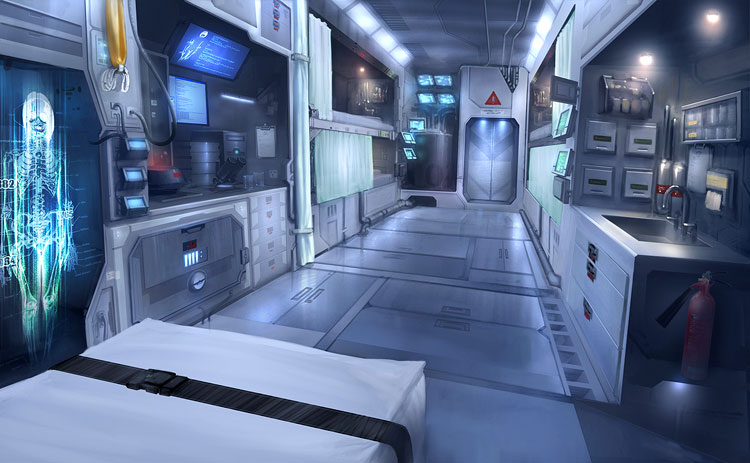
- 4x Exam Rooms

-24x Medical Beds
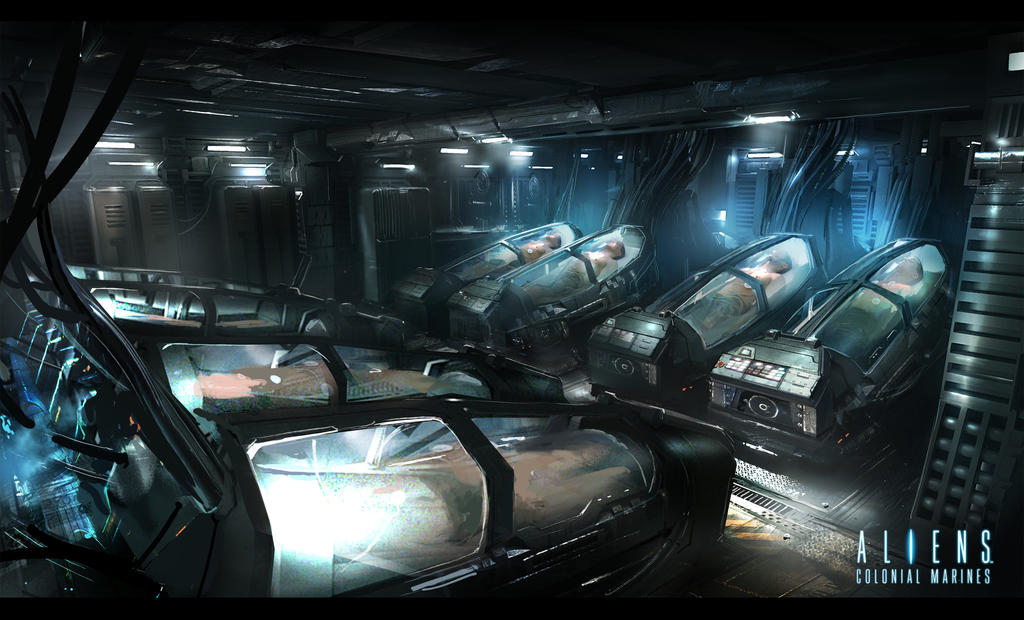
-8x Bacta Tanks
-2x Surgery Rooms
2x surgery rooms, 4x private exam rooms, 8 bacta tanks, 24 medical beds,
main triage area capable of supporting 120 non-critical patients
women's medical specialists in medbay
pharmacy in/next to medical bay
Brig-
Images
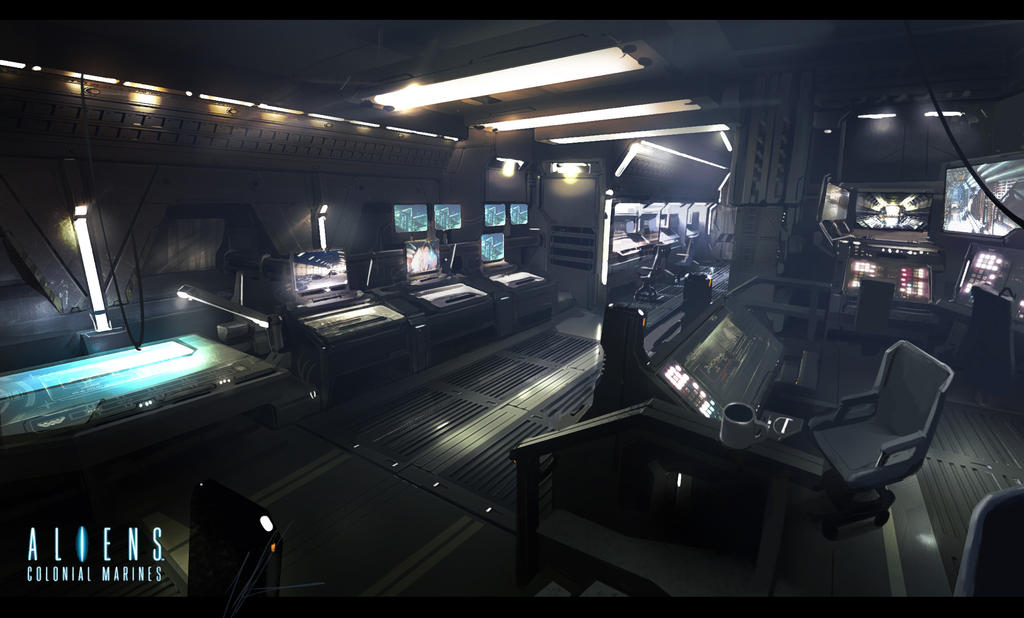
- Security Monitoring Station
- Detention Cells
Lifeboats and Distress Beacons-
Images
In the event of an emergency or should the ship sustain extreme and unsurvivable combat damage, the axial edges of the star destroyer incorporates two hundred and fifty lifeboats on either side of the ship. For those operating in or near the bridge, a further 50 lifeboats are worked into the aft 'ridge' that braces the bridge. Each of these lifeboats is able to sustain 12 adult humans for two weeks and, while lacking a hyperdrive, is capable of sublight propulsion and is programmed to automatically fly towards and land upon the closest habitable planet. This automated navigation can be disabled should the need arise. The boat is equipped with enough food and water to sustain its twelve passengers for twelve months on heavy rationing, comes with a basic first aid kit, and twelve portable comm units. The dorsal side of the lifeboat incorporates a solar panel that can be used, in theory, to provide enough power to the lifepod for it to serve as shelter for over a decade. Powercell charging stations and water purification systems are built into the lifeboat on the off chance that a surviving crew is forced to live on a planet for several months or years before a suitable rescue can be made. Though the lifeboat incorporates a long-range communications system, it does not include subspace or hyperspace communication capabilities.
The Victory III-class Star Destroyer is equipped with ten PED-21 Distress Beacons. Should the worst come to pass, the bridge officers of the ship are able to enact an automated procedure that launches eight of the hyperspace capable beacons towards the eight closest hyperspace routes or high-population systems. A ninth beacon is deployed at the Star Destroyer's current location and the tenth beacon iss held in reserve until the ship's automated systems determine that as many of the ship's crew have evacuated as can be reasonably expected. At that time, the tenth and final hyperspace beacon is deployed and travels towards the closes habitable planet. While the Hyperspace Beacon is not equipped to land on a planet, it is capable of arranging itself into a geostationary orbit and can be remotely programmed by any nearby lifepod to transmit a specific message, often including the location and status of the ship's crew as well as the specific fate of the ship itself.
Supplemental Crew-
Images
As a standard complement, each Victory III Star Destroyer included a small army of maintenance droids to help maintain the ship and augment the capabilities of the crew. 800 MSE droids are often tasked with the general cleanliness of all floors, the maintenance of nearly anything within reach of its small arms, and whatever other tasks a crewmember can program into one instead of do himself. 50 MK droids and 25 R3 droids assist with the maintenance and calibration of the ships many weapon systems while 12 BLX droids aid crew in the cargo bays and hangers. Five Hatchling droids aid in the occasional external calibration and maintenance of the ship's many weapon systems in addition to cleaning mynocks from the hull. Supplementing the security detail and infantry of the Star Destroyer, as well as aiding in the resolution of any drunken disputes, 80 Droideka Battle Droids are kept in various areas of the ship. Their ability to rapidly arrive at the scene of a dispute proving invaluable among the twisting corridors of a 900 meter long warship. When a security situation could not be dealt with by a pair of Droideka or whatever assets the ship's crew could muster, a squad of 12 YVH1 droids was deployed from a location very close to the ships brig and arrived as a unit to quell or calm the situation. When not called upon, these droids are kept inactive and are stored within a number of small closets labeled "Security Personnel". Overseeing the use and deployment of battle-droid forces and generally assisting the security forces of the ship is a 501-Z Police Droid.
TYPICAL SHIP TECHNICAL DETAILS
- Minimum Crew: 1,785
- Optimal Crew: 6,200
- Supplementary Crew: 800 MSE Droids, 50 MK Droids, 25 R3 Droids, 12 BLX Droids, 5 Hatchling Droids
- Passenger Capacity: 2,040 Stormtroopers
- Supplementary Security: 80 Droidekas, 12 YVH1 Droids, 1 501-Z Police Droid





